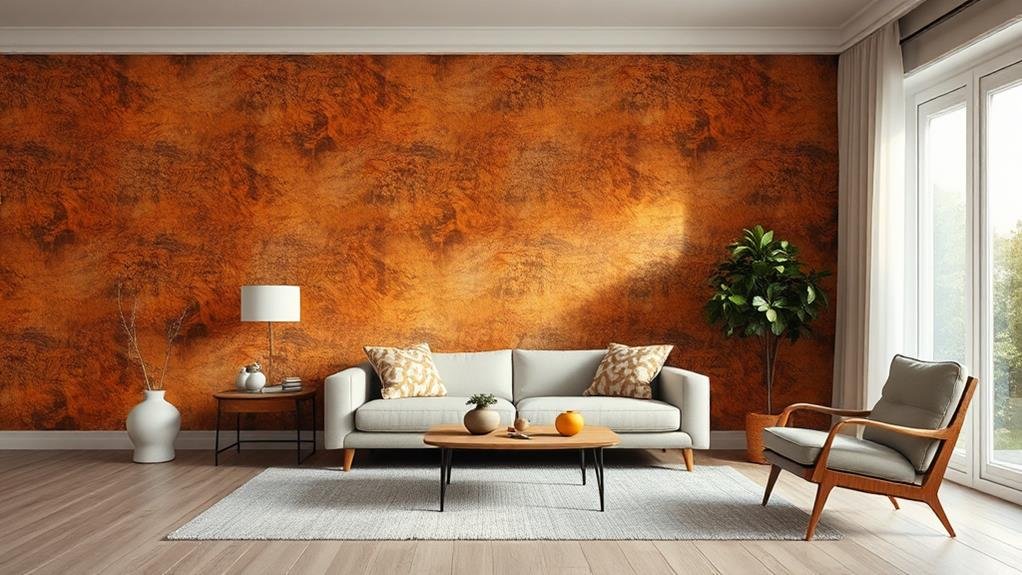Step into the mesmerizing world of interior design, where every corner tells a unique tale through a symphony of colors, textures, and lighting. Discover the balance between functionality and aesthetics as you explore the art of furniture placement, creating harmonious spaces that flow effortlessly. Embrace the power of natural illumination and strategic lighting placement to set the perfect ambiance for your haven. From personalization to current trends, the essence of interior design lies in crafting spaces that reflect your individuality and lifestyle. Unravel the secrets of sustainability and global influences to elevate your space to new heights.
Key Takeaways
- Blend past traditions with modern innovations for inspired design.
- Colors evoke emotions and influence mood; understand their impact.
- Furniture arrangement maximizes space; use multi-functional pieces.
- Lighting transforms spaces, enhancing ambiance and mood.
- Textures, patterns, balance, and personalization enhance visual appeal and individuality.
History of Interior Design
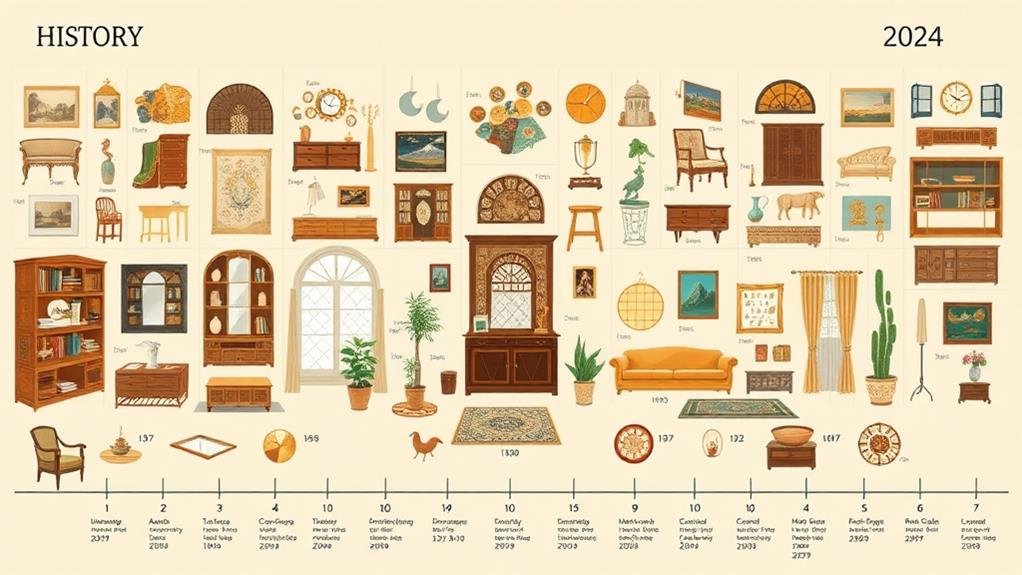
Exploring the rich tapestry of time, the history of interior design weaves a captivating narrative of human creativity and ingenuity. From ancient styles rooted in Egyptian and Roman civilizations to the modern influences of the 21st century, interior design has evolved through cultural variations and design movements.
Technological advancements have revolutionized spatial awareness in both residential and commercial spaces.
Famous designers such as Frank Lloyd Wright and Elsie de Wolfe have left lasting legacies, shaping the aesthetic principles of interior design. Through the ages, color palettes have played a vital role in creating ambiance and evoking emotions within spaces. Whether vibrant and bold or soft and muted, colors have the power to transform the mood of a room.
Understanding the historical context of interior design allows one to appreciate the deep-rooted traditions and innovative approaches that have shaped the spaces we inhabit today. By blending the past with the present, interior design continues to push boundaries and inspire new possibilities.
Color Psychology in Design
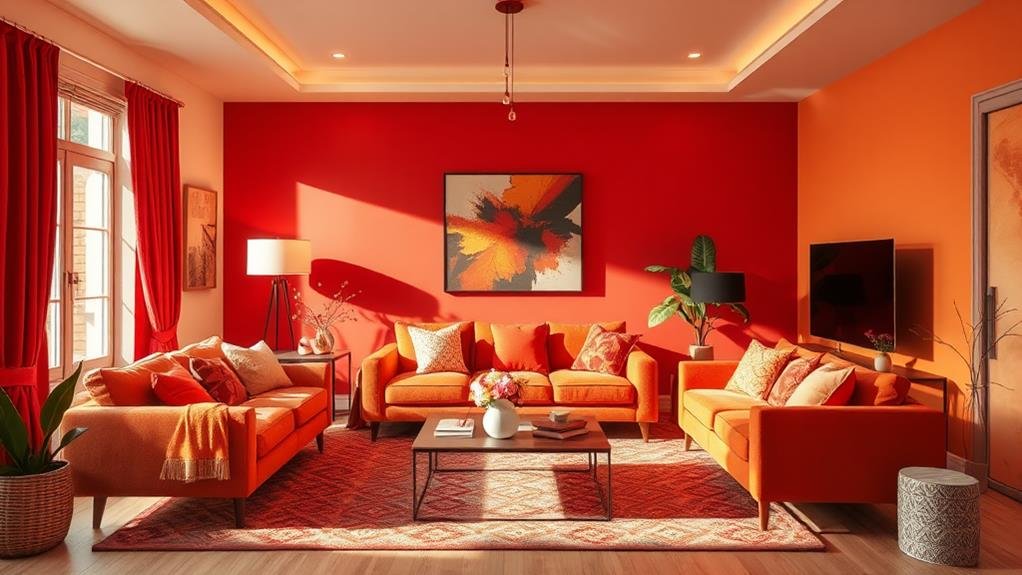
Ready to unleash the transformative power of colors in your interior design?
Colors have the remarkable ability to evoke emotional responses, influencing your mood and perception of a space. By strategically incorporating colors, you can create harmonious environments that uplift, calm, or energize, tailored to your unique preferences and needs.
Impact of Colors
Bathed in a spectrum of hues, the world of interior design holds a secret power – the impact of colors. Color symbolism plays a crucial role, as different shades evoke varied emotions and perceptions.
Cultural influences shape color preferences, with some cultures favoring warm hues for coziness while others opt for cool tones to create a sense of serenity. Seasonal palettes guide designers towards refreshing spring pastels, vibrant summer shades, cozy autumnal hues, and icy winter blues. Staying attuned to color trends helps in creating spaces that feel current and inviting.
When exploring color combinations, designers often experiment with monochromatic schemes for a harmonious feel, or juxtapose contrasting colors for a dynamic effect. Incorporating accent colors strategically can add pops of personality and visual interest to a room.
Understanding the impact of colors allows designers to wield a powerful tool that can transform spaces, evoke emotions, and enhance experiences within a room.
Emotional Responses to Colors
Within the realm of interior design, colors hold a captivating sway over our emotions and perceptions. The emotional responses to colors are a fascinating interplay of associations, warmth, symbolism, enhancement of moods, psychological effects, personal preferences, and sensory experiences.
Different hues evoke diverse reactions. For instance, warm colors like reds and oranges exude energy, passion, and coziness, while blues and greens are calming and promote tranquility. Cultural influences play a significant role as well; for example, white symbolizes purity in Western cultures but signifies mourning in some Eastern societies.
Your emotional connection to colors is deeply personal and can greatly impact your mood and overall well-being. Understanding color psychology in design allows you to create spaces that resonate with your emotions and aspirations.
Whether you prefer vibrant shades that invigorate your senses or muted tones that foster relaxation, the colors you choose shape the ambiance of your environment and influence how you feel within that space.
Embrace the power of colors to craft interiors that speak to your heart and soul.
Furniture Placement Techniques
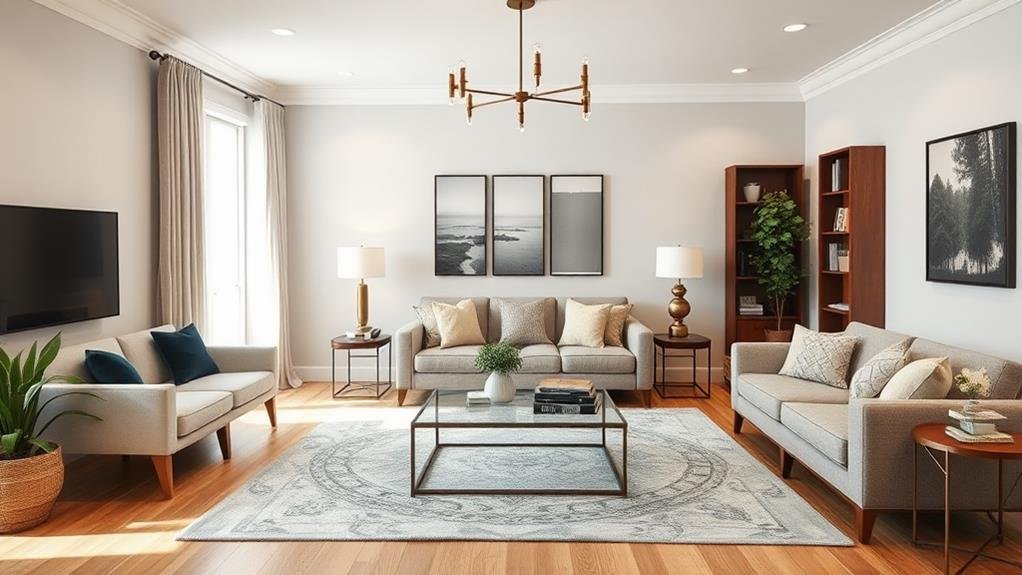
Positioning furniture in a room is more than just filling space; it's about creating balance and flow. The way you arrange your furniture can greatly impact the overall atmosphere and functionality of the space.
- Furniture Arrangement: Strategically placing furniture to maximize space utilization and create functional zones.
- Layout Flow: Ensuring a smooth flow of movement throughout the room by considering traffic patterns and ergonomics.
- Aesthetic Balance: Balancing the visual elements in the room by selecting the right pieces and positioning them harmoniously.
- Room Zoning: Dividing the space into distinct areas for different activities using furniture as boundaries or separators.
Consider using multi-purpose furniture to optimize space and serve dual functions.
Create focal points with statement pieces and ensure that each item contributes to the overall aesthetic and functionality of the room.
Importance of Lighting
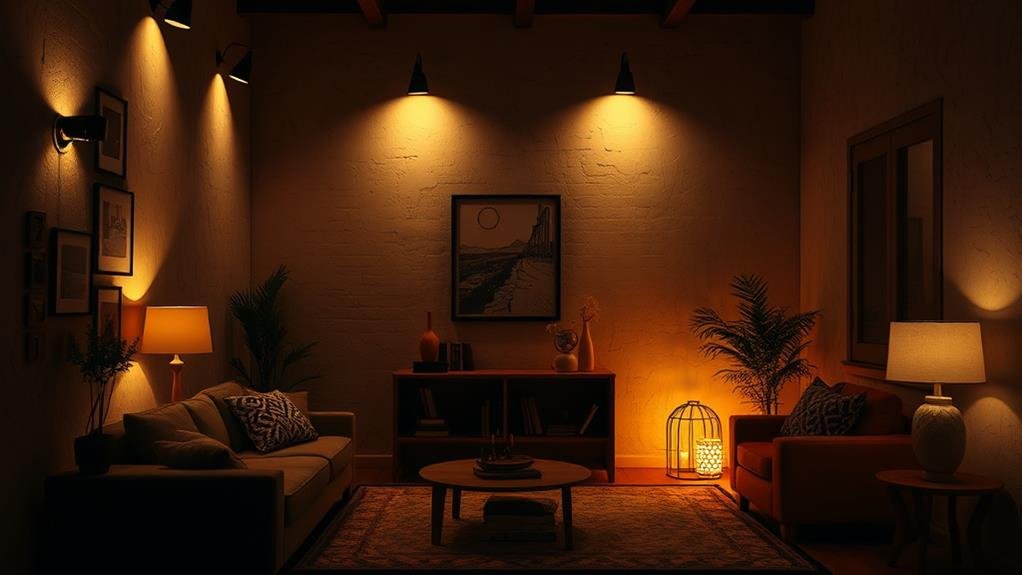
When it comes to interior design, lighting plays a pivotal role in creating the perfect ambiance in a room.
Lighting can transform a space from dull to vibrant, setting the mood and enhancing the overall aesthetic appeal.
Lighting Enhances Ambiance
A well-designed space is often defined not just by its furniture or color scheme, but by the way lighting enhances its ambiance.
Lighting plays a crucial role in setting the mood and atmosphere of a room, offering various ways to create an inviting and comfortable space.
- Mood Enhancement: The right lighting can significantly impact the overall mood of a room, whether soft and calming or energizing and vibrant.
- Light Layering: By incorporating different layers of light, such as ambient, task, and accent lighting, you can add depth and dimension to a space.
- Fixture Selection: Choosing the right fixtures can blend functionality with style while complementing the overall design of the room.
- Natural Illumination: Harnessing natural light not only saves energy but also brings a sense of freshness and connection to the outdoors.
Through a thoughtful combination of color temperature, decorative lighting elements, energy-efficient solutions, and proper light diffusion, you can create a space where lighting enhances every aspect of the ambiance.
Strategic Lighting Placement
Nestled within the very essence of interior design lies a crucial element that often determines the success of a space – strategic lighting placement. Illuminating a room goes beyond mere functionality; it holds the power to transform the entire ambiance and feel of an environment.
When considering strategic lighting placement, one mustn't overlook the importance of utilizing a mix of lighting fixtures such as ambient lighting, task lighting, and accent lighting to create depth and visual interest.
Natural light should also be taken into account as it can enhance the overall beauty of a space. Light layering, where different types of lighting sources are combined, helps in creating various moods and meeting specific lighting needs throughout the day.
Paying attention to color temperature is crucial for setting the right tone in a room, while focusing on energy efficiency and smart lighting technologies can both save energy and contribute to sustainable design practices.
Moreover, seasonal lighting adjustments can bring forth a sense of freshness and adaptability to any interior.
Strategic lighting placement truly holds the key to elevating the design and livability of a space.
Textures and Patterns
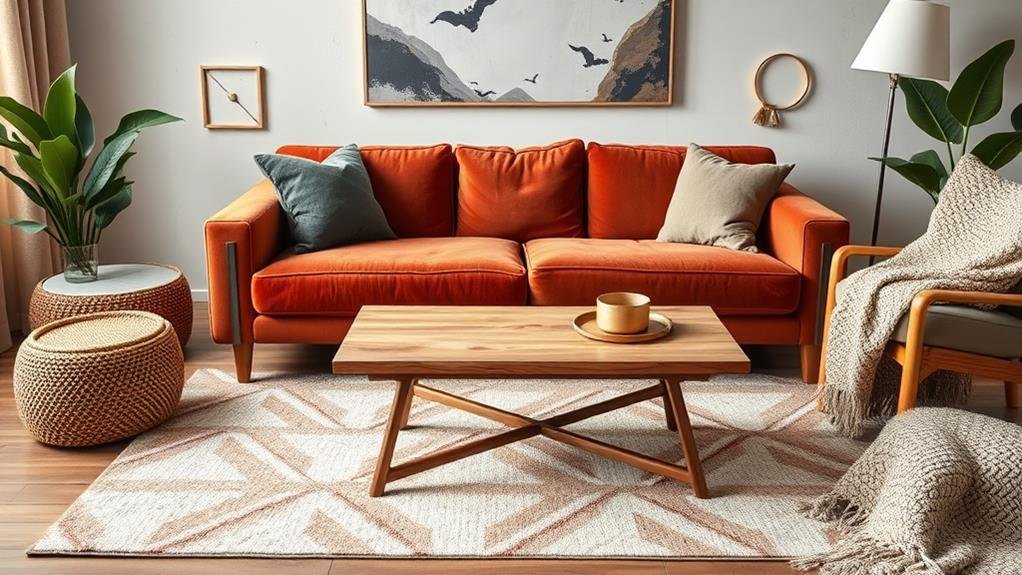
Exploring the realm of interior design unveils a world where textures and patterns play an integral role in creating visual interest and adding depth to a space.
When it comes to designing your living space, incorporating various textures and patterns can elevate the ambiance and bring your vision to life.
Here's how you can utilize textures and patterns to transform your space:
- Textile Combinations: Experiment with mixing different textiles like velvet, linen, or leather to add richness and diversity to your decor.
- Pattern Layering: Layering different patterns such as stripes, florals, or geometric prints can create a dynamic and visually appealing space.
- Tactile Experiences: Introduce elements like plush carpets, soft throws, or textured wallpapers to engage your sense of touch and enhance the overall atmosphere.
- Cultural Influences: Draw inspiration from different cultures to infuse unique textures and patterns that reflect a rich tapestry of traditions into your interior design.
Maximizing Small Spaces
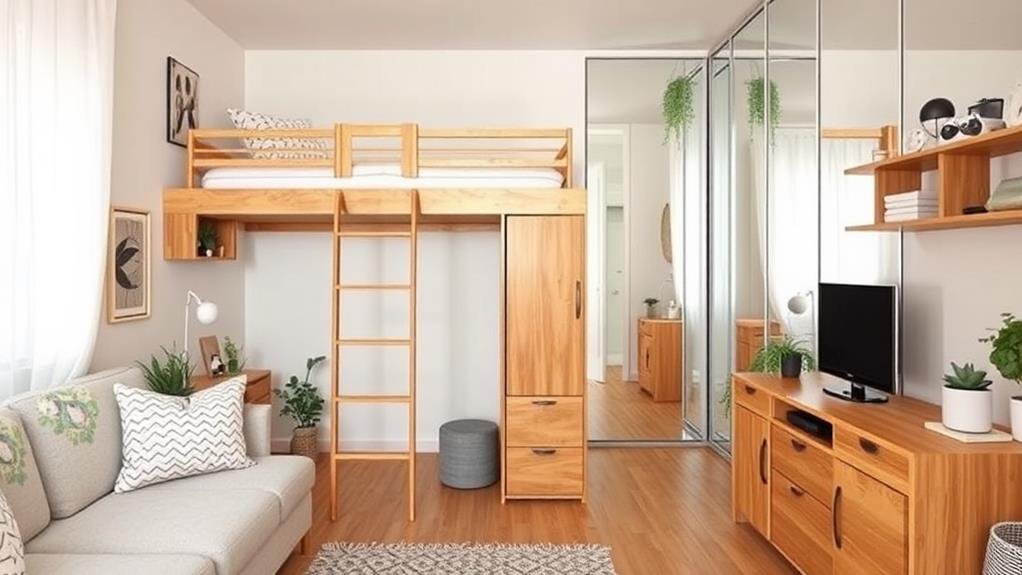
Ready to transform your cramped quarters into a functional haven?
Embrace multifunctional furniture pieces and nifty storage solutions to optimize every inch of your space.
With a strategic layout design, you can create flow and maximize both aesthetics and functionality in your small area.
Space-Saving Furniture Solutions
In small living spaces, the challenge of maximizing functionality and comfort can often feel daunting.
However, with the right space-saving furniture solutions, you can transform your compact area into a stylish and practical haven.
Here are some innovative ideas to help you make the most out of your urban living space:
- Multifunctional Designs: Look for furniture pieces that serve more than one purpose, like a sofa that turns into a bed or a coffee table with hidden storage compartments.
- Modular Furniture: Opt for customizable units that can be easily rearranged to suit your evolving needs, providing flexibility in your layout.
- Compact Storage: Utilize vertical space with wall-mounted shelves, under-bed drawers, or ottomans that open up to store blankets, books, and more.
- Transformable Pieces: Invest in furniture that can transform or expand when needed, such as extendable dining tables or nesting tables that can be stacked together when not in use.
Strategic Layout Design
Amid the constraints of small living spaces, the strategic design of your layout becomes paramount in optimizing every inch of available space. By applying zoning principles and considering flow patterns, you can enhance spatial relationships within your home.
Scale considerations play a crucial role in ensuring that furniture and decor items fit harmoniously to avoid overwhelming the space.
Creating multifunctional areas promotes design flexibility, allowing spaces to adapt to various needs seamlessly. Movement pathways should be clear and intuitive, enhancing the user experience and facilitating easy navigation throughout the rooms.
Through effective area delineation, you can clearly define different functions within the space while maintaining a cohesive overall design.
The key to successful layout optimization lies in balancing functionality with aesthetics, ensuring that every element serves a purpose while contributing to the visual appeal of the space.
Embrace the challenge of maximizing small spaces by strategically designing your layout to create a harmonious and efficient living environment.
Creating Visual Harmony
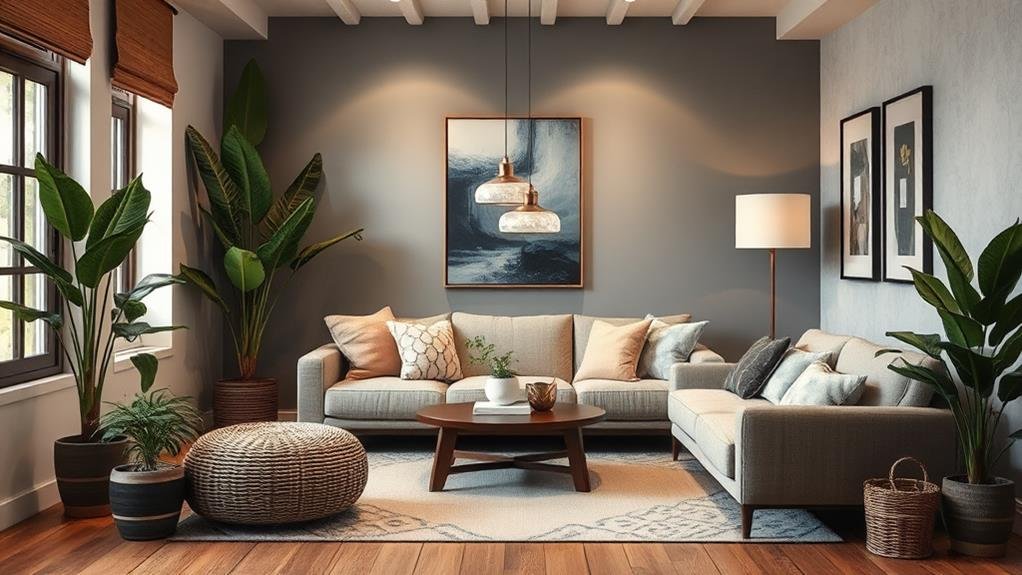
Harmonizing the visual elements within a space is akin to orchestrating a symphony of colors, textures, and forms. Achieving visual harmony involves marrying various design elements seamlessly to create a coherent and pleasing aesthetic.
To master this art, consider the following:
- Cohesive Elements: Ensure that all elements in the room tie together harmoniously, from furniture to decor, creating a cohesive look.
- Spatial Awareness: Understand the layout of the space to utilize it effectively, ensuring a balanced and visually appealing design flow.
- Color Consistency: Maintain a consistent color palette throughout the room to create a sense of unity and cohesion.
- Sensory Experience: Incorporate textures and materials that not only look good but also contribute to the overall sensory experience, enhancing the ambiance of the room.
Balance and Symmetry
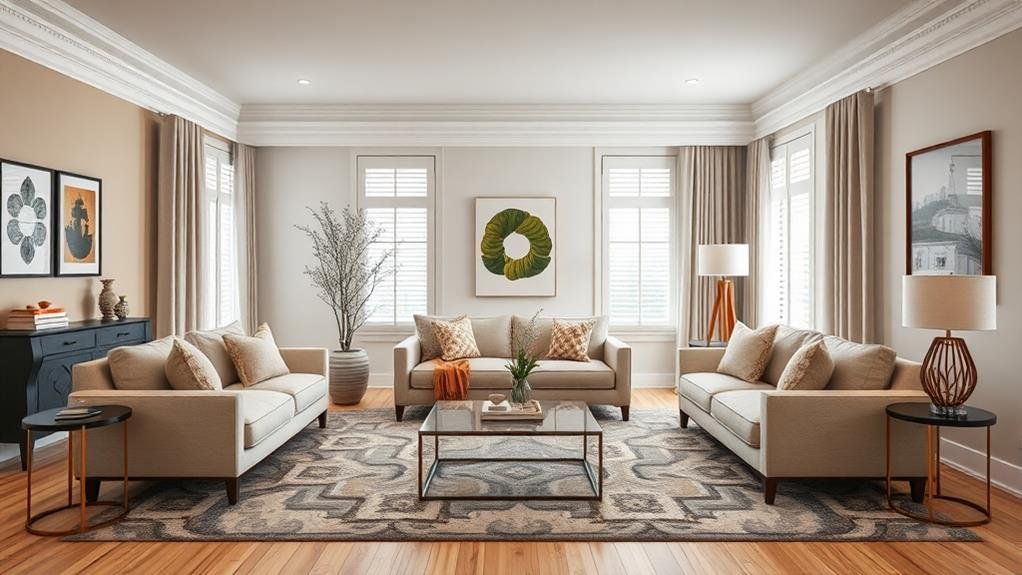
As the design symphony continues its crescendo, a crucial aspect that infuses depth and sophistication into the visual narrative is the delicate dance of balance and symmetry. These design principles play a pivotal role in creating spaces that feel harmonious and visually pleasing to the eye.
When considering balance and symmetry in interior design, it's essential to understand the concept of visual weight. Spatial arrangement, focal points, and harmony techniques all contribute to achieving a sense of equilibrium within a room. By following proportion rules and utilizing symmetrical layouts, you can establish an aesthetic balance that promotes a feeling of order and tranquility.
Symmetry, in particular, can offer a sense of familiarity and stability. Placing identical elements on either side of a central axis can create a sense of equilibrium and formality in a space.
However, balance doesn't always mean perfect symmetry; asymmetrical arrangements can also be visually engaging and dynamic, adding a layer of interest to the design.
Functionality Vs Aesthetics
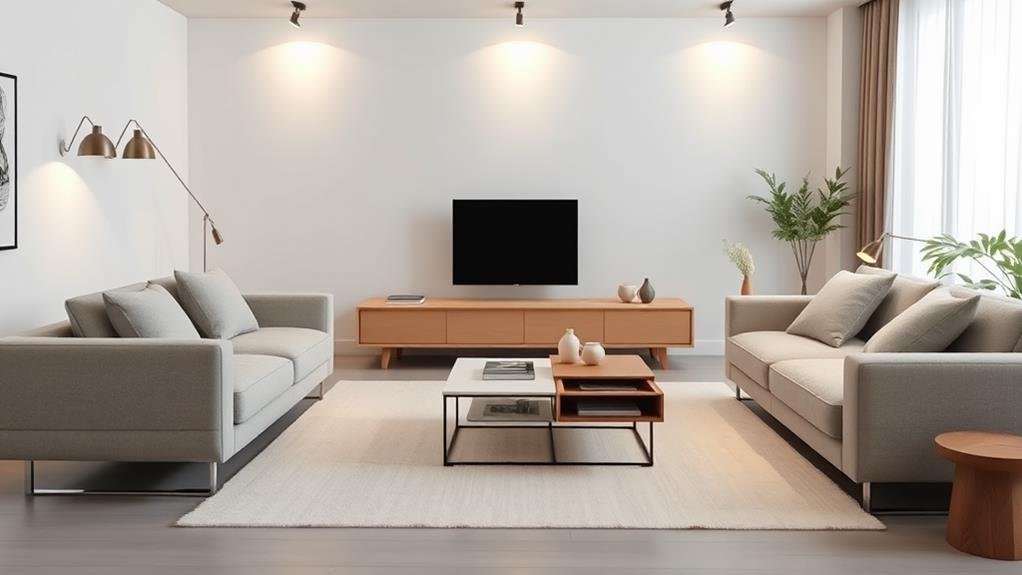
Have you ever pondered the delicate balance between functionality and aesthetics in interior design?
Design principles dictate that a successful space must blend both aspects seamlessly to create a harmonious environment that not only looks beautiful but also serves its purpose effectively.
Here's a closer look at the interplay between functionality and aesthetics:
- Space functionality takes precedence: A well-designed space should prioritize usability and efficiency without compromising on visual appeal.
- User experience is key: Every element in a room should enhance the overall experience of those who inhabit it, balancing comfort and practicality.
- Visual balance is crucial: Achieving a visually pleasing environment involves arranging elements in a way that's both aesthetically pleasing and functional.
- Ergonomic design for practical aesthetics: Furniture and decor shouldn't only look good but also be designed for comfortable and efficient use, reflecting a design philosophy that values both fashion and function.
Integrating lifestyle needs with design aesthetics results in spaces that embody practical beauty, where form meets function seamlessly.
Personalizing Your Space
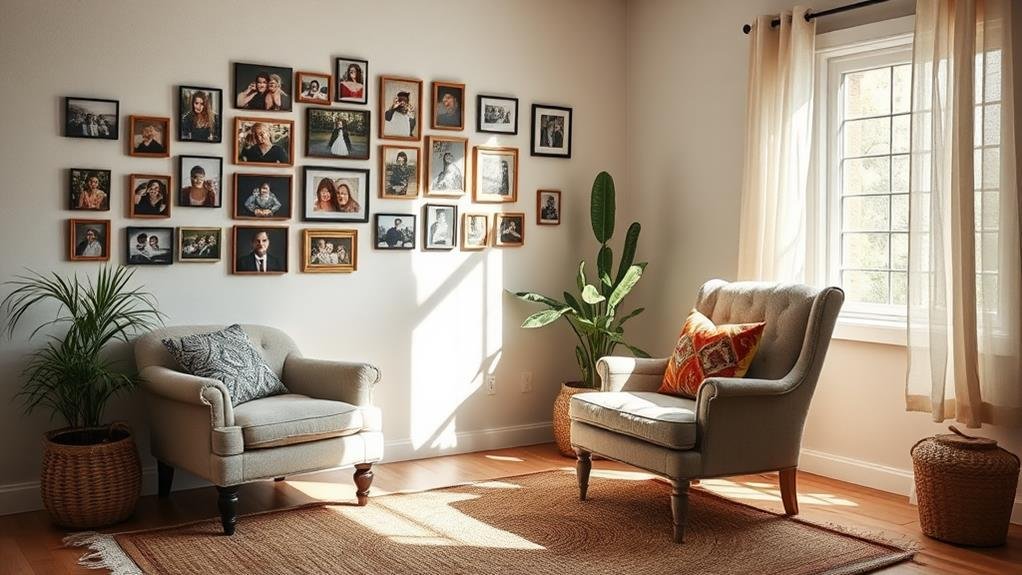
When it comes to crafting a truly intimate and unique living space, personalization holds the key to transforming a house into a home. Your personal style shines through in every corner, making it a reflection of your essence. Incorporating meaningful decor pieces, influenced by your cultural background, creates a sense of belonging and comfort. Displaying personal collections adds a touch of nostalgia and individuality to the space. Engaging in DIY projects not only adds a personal touch but also creates emotional connections to your home.
Imagine a space where functional art meets home narratives, weaving stories through every piece. Each room becomes a sensory experience, stimulating not just sight but touch, smell, and even taste. Unique themes can transport you to different worlds within your own abode, allowing for escapism and creativity to flourish.
| Personal Style | Cultural Influences | DIY Projects |
|---|---|---|
| Meaningful Decor | Personal Collections | Emotional Connections |
Trends in Interior Design
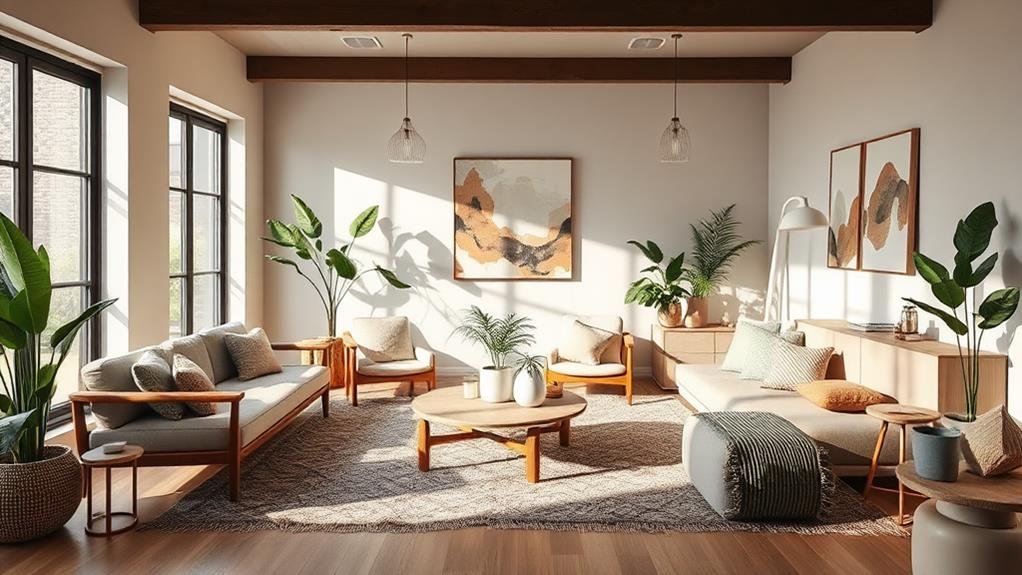
Picturing your ideal living space involves not just introspection and self-expression but also a keen eye on the latest trends in interior design.
Embrace the dynamic world of interior design with an exploration of the following trends:
- Vintage Revival: Incorporating elements of bygone eras adds character and history to contemporary spaces.
- Smart Technology: Seamlessly integrating technology enhances the functionality and convenience of your living environment.
- Biophilic Design: Connecting with nature through green spaces and natural elements promotes well-being and tranquility within your home.
- Global Influences: Drawing inspiration from diverse cultures and traditions infuses your space with a rich tapestry of textures, colors, and motifs.
As trends evolve, minimalist aesthetics, eclectic styles, monochromatic schemes, artisanal craftsmanship, sustainable materials, and open concept layouts continue to shape modern interiors.
Stay attuned to these influences to create a space that reflects your personality while remaining current and stylish.
Sustainability in Design
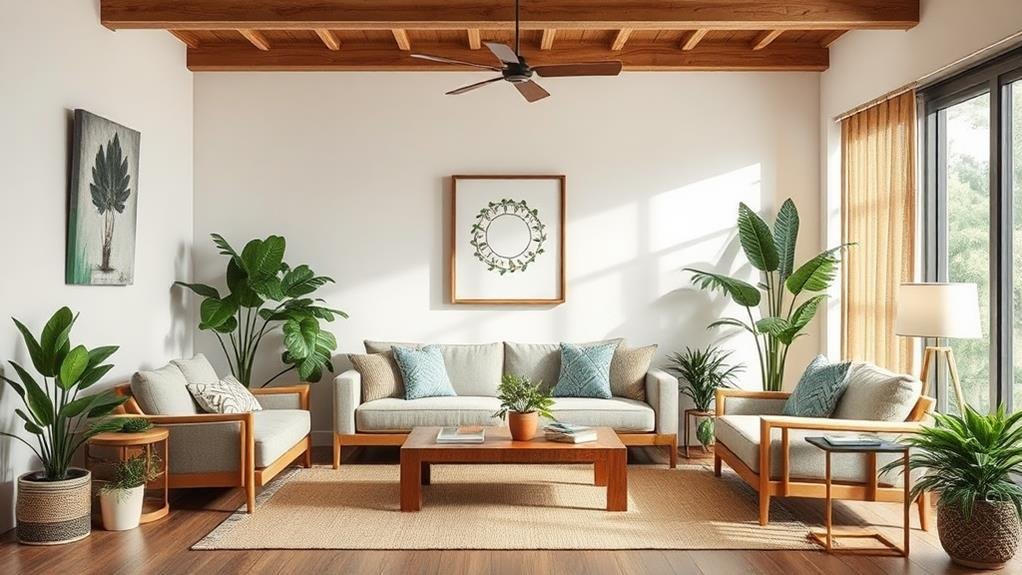
To truly embrace sustainable design practices, you must weave eco-conscious principles seamlessly into the fabric of your living space.
Start by selecting eco-friendly materials like bamboo, reclaimed wood, or recycled glass for your furniture and decor. Embrace sustainable practices such as ethical sourcing and supporting brands with green certifications. Opt for renewable resources like cork flooring or organic cotton textiles.
Ensure minimal waste by incorporating biophilic design elements that connect you with nature. Conduct lifecycle analysis when choosing products to understand their environmental impact.
Prioritize energy efficiency by utilizing LED lighting and smart home technologies. Consider upcycling furniture to give new life to old pieces and reduce consumption.
Conclusion
In conclusion, interior design is like a blank canvas waiting for your artistic touch. So go ahead and put your stamp on it, make it your own and let your creativity shine through. Remember, the devil is in the details, so don't be afraid to play around with colors, textures, and furniture placement. Embrace the trends, but always stay true to your personal style. Your home should be a reflection of you – make it as unique and fabulous as you are!

